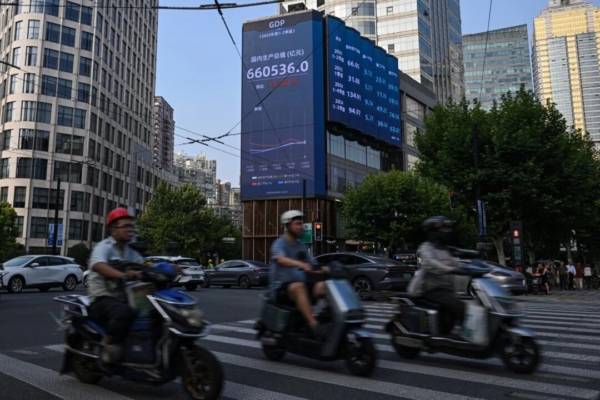The Chinese Communist Party’s official portrayal of the 2025 economic recovery is akin to a classic textbook-style magic show. The government claims that the GDP growth rate in the first half of the year was 5%, and surface data also indicates that the economy has bounced back from the stagnation during the pandemic.
However, beneath this glossy surface lies China’s fragile economic structure – relying on debt, long-term deflation, and opaque manipulation. The danger for global markets and policymakers lies not only in its inherent fragility but also in the continued misperception of China as a stable, predictable economic partner.
For example, in July, industrial output grew by 6.1% year-on-year, and exports unexpectedly increased by 7.2% year-on-year. However, these figures are carefully manipulated. Retail growth slowed to just 3.7%, and the Consumer Price Index (CPI) remained stagnant at 0.0%.
The Producer Price Index (PPI) has been declining for 32 consecutive months, making China a continuous deflationary exporter. Goldman Sachs predicts that China’s annual CPI will remain at 0.8%. Meanwhile, wholesale prices continue to decline, with industrial producer prices falling by 3.3% year-on-year, according to the Chinese National Statistics Bureau.
This “Xi-style deflation” is not a random occurrence in macroeconomics but a reflection of deep-seated pessimism. Families postpone consumption, hoping for price drops. Businesses scale back investments, struggling to expand profit margins in weak demand conditions. Economic growth increasingly relies on policy-driven transfers and subsidies, rather than productive output. Innovation, manufacturing efficiency, and export competitiveness all pale due to CCP intervention.
The CCP’s response is to increase fiscal intervention. Subsidies for appliances and car trade-ins temporarily stimulated consumption but with short-lived economic effects, lasting only on a monthly basis. Once the stimulus measures are withdrawn, demand will plummet. Worse still, the burden of funding these measures falls on local governments, which are already financially depleted due to declining land sales and significantly reduced tax revenue.
This hidden structural risk poses a severe challenge. The scale of local government debt issuance has raised concerns among official creditors. Fitch Ratings has warned of risks of funding chain breaks in the more than 8 trillion yuan of Local Government Financing Vehicles (LGFV) debt.
Analysts at Yuekai Securities estimate that total local government debt has surpassed 51 trillion yuan, with the majority of funds directed towards non-productive or politically motivated projects. Since 2020, debt levels have nearly doubled due to off-budget financing and stimulus spending. This is not genuine economic stimulus but a means to keep poorly performing entities operational, delaying crucial structural adjustments.
These practices entail secondary risks. As local governments allocate resources to debt repayment, their ability to fund healthcare, social welfare, and infrastructure is weakened. For foreign investors and multinational corporations, the evident risk signal is that local partners may have more debts than publicly disclosed and are more vulnerable. Sovereign risk levels rise, contractual stability diminishes, and the probability of regulatory policy shifts increases.
The opacity of Chinese economic data exacerbates these risks. An investigation by The Wall Street Journal found that hundreds of statistics related to land sales, foreign direct investment inflows, and soy sauce production had been removed. Rongding Consulting estimates that China’s GDP may be overestimated by at least 10%, or $1.7 trillion.
Access to accurate information is challenging due to data suppression linked to political control: under the revised “Conservative National Secrets Law,” economists and analysts critical of CCP leader Xi Jinping’s policies either disappear or are silenced.
The global financial system relies on transparency to assess price risks, and the CCP’s selective information suppression poses systemic risks. Resource misallocation issues worsen when policymaking relies on flawed data. Investors accustomed to cross-verification among official data, independent research, and on-the-ground indicators face uncertainty in seeking reliable data.
This is a deliberate choice in CCP internal governance that has international economic implications. Driving down global market prices through low-cost exports puts pressure on manufacturing industries in other countries. Often, state-supported enterprises sell at prices below cost, making it challenging for market economy competitors to contend. Meanwhile, CCP local governments adjust policies to attract foreign investors to address debt issues. While this can quickly bring in funds, it may cause long-term damage to economic stability and institutional trust.
The consequences of CCP policies compel a reassessment of interactions with China. Foreign investment cannot simply view the Chinese market as a high-yield, politically unaffected investment destination. Risk exposure adjustments must prioritize political risk, subsidy uncertainty, and potential abrupt restrictions from cooperative entities before adjusting interest rates, trade policies, or investment review mechanisms.
Before adjusting interest rates, trade policies, or investment review mechanisms, policymakers in trading countries must independently verify unreliable Chinese economic data. Multinational companies have a responsibility to incorporate operational resilience into their China strategies, plan for sudden shifts in CCP policies, and consider potential regional instability factors when local finances face difficulties.
Portraying China’s economy as resilient is, in fact, masking its structural fragility rather than cyclical fluctuations. Manually manipulated statistics, politically-driven credit allocation, and exacerbating financial depletion are neither sustainable nor benign developments. Treating official statements as facts poses financial risks and leads to strategic misalignment.
While China may appear stable on the surface, it is propped up by meticulously crafted statistics and tightly controlled information dissemination. However, this “stability” rests upon hidden debts and opaque financial operations, its core vulnerability is undeniable. For leaders worldwide, the conclusion is straightforward: do not easily trust the CCP’s official narrative; it is not a neutral description of the economy but a crucial strategic narrative meant to mask underlying fragility.
(Note: The author’s information and the original source are omitted as requested.)

